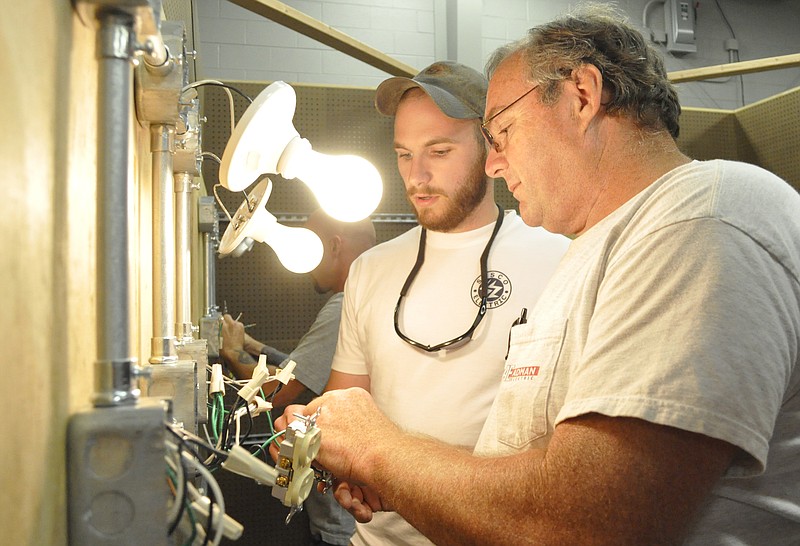Manufacturers have a problem. With demand picking up for their chemicals, carpet and cars, the region's key companies need new employees to replace retiring workers and expand production. Trained, willing employees.
Shaw Industries is an example. The giant carpetmaker, among the largest employers in Northwest Georgia with nearly 23,000 workers, expects to lose as much as 25 percent of its workforce to retirement in the next five to seven years. The other large manufacturers expect to see much the same thing, says Brian Cooksey, director of operations training and development for Shaw.
"It's not only the new folks we need and the new skills, but we need to replace the retirements," Cooksey says.
To be sure, there are plenty of unemployed workers looking for work. In the Chattanooga area, 14,500 workers were actively looking for jobs in May 2015 alone. In Dalton, Georgia, 4,000 workers sought jobs in May, according to the U.S. Bureau of Labor Statistics.
But there is a disconnect between thousands of workers hunting for work and the companies across the region who say they have equal or even greater numbers of positions they can't fill.
The employment website for the state of Georgia, EmployGeorgia.com, showed nearly 700,000 job openings across the state in mid-July. Keith Owensby, assistant training director at the Chattanooga Electrical Apprenticeship and Training center, says that of the program's 340 apprentices, nearly all are working.
"We could use more," he says. "If you've got the skill and the mindset to come on time and pass the drug test and all that, there are opportunities. That's with all the building trades: carpentry, plumbing, right now there's plenty of work."
Cooksey says Shaw and the other flooring manufacturers could currently fill hundreds of jobs in the industrial maintenance field alone.
But many job-seekers lack the skills necessary to work in an increasingly automated manufacturing environment, businesses say. Jobs that once required workers to yank a lever or push around a shipping crate now require workers to understand high-tech processes, work as part of a team and learn new skills on a regular basis. And some can't or won't take the time to train.
The issue, companies say, is that some job seekers emerging from public schools do not have the skills needed by employers, especially mechanical and interpersonal skills. Instead, public schools are set up to prepare students for a four-year degree, even students who have no desire or even ability to pursue such a degree, or who may be more technically inclined, companies say.
The gulf between what companies need and what job candidates possess is why employers are struggling to fill open positions with willing, trained workers, says Mark Butler, commissioner of the Georgia Department of Labor.
"The jobs are there, we have plenty of jobs," Butler says. "There are a lot of people who aren't getting jobs right now, not because they can't do the job, but because they're tripping over their own feet. They are tying their own shoelaces together."
For now, employers like Shaw Industries, Wacker Polysilicon, and Covenant Transport are picking up the slack themselves by partnering with technical schools and launching apprenticeship programs to mold job-seekers into suitable candidates.
Such cozy relationships between businesses and educators may be a new, perhaps even frightening, idea for many in the U.S., but it's something the Germans have done successfully for many years, says Erika Burk, human resources director for Wacker Polysilicon.
"In the past, everybody was focused on getting a four-year degree, that was the way to go," Burk says. "But people never finished their four-year degree, and they struggled in the work force because they had no area of expertise. I think it's important that people realize that getting a two-year degree, you can start at a company and it's a great way to get your foot in the door, make a very good living and earn as much as an engineer coming out of a four-year program."
Wacker has launched three educational programs to try to find and prepare qualified men and women to work at its plant in Charleston, Tennessee.
First, there's the Wacker Institute, an intensive six-month program to bring operators up to speed on chemical engineering, technology and the theory behind the creation of polysilicon, which goes into solar panels. After the classwork, students were sent to Germany for more hands-on training.
The second piece of the puzzle is an engineering technology program held at Chattanooga State Community College, which trains workers not just for Wacker, but for other regional employers who need qualified workers. Wacker alone has hired 100 graduates of this program, Burk says.
And finally, Wacker has launched an apprenticeship program, which gives students a summer semester of on-the-job training that is integrated into the school week. The company, which is specifically seeking workers who can maintain its advanced machinery, offers apprenticeships in mechanical, electrical and chemical fields, Burk says. Students work one to two full days on the job each week during the day shift. They'll learn how to handle hazardous chemicals, how to do conversions and basic math, apply chemistry and understand chemical reactions, she says.
"The students take their coursework, we'll pay for their books and [personal protection equipment], and for the hours they work during the week," Burk says.
But even getting into the program requires a starting set of skills not possessed by all job-seekers. Students need the equivalent of a 19 on the ACT in math, and need soft skills like the ability to be able to read and comprehend English.
"If not, the consequences can be very serious," she says. "They're not coming into the plant with no background and just learning on the job."
The ability to read and follow instructions, to dress appropriately for the situation, to show up on time, those skills can be just as important as the ability to do a quadratic equation, Butler says. In his role as commissioner of the state's labor department, Butler has launched business ethics student training in some of the state's public schools to develop the soft skills that aren't taught in a textbook.
As Butler tells the story, every time he speaks to a group of business leaders he always asks the same question: How many times has a job candidate reported to work wearing pajamas? Inevitably, anywhere from three to five hands shoot up, he says.
"To me, the best measurements of any school is what does the kid do when he leaves there? Is he getting a job, is he being productive and are the employers in the area, are they getting a graduate who can step in there and go to work and do well?" Butler says. "That's why we go to school, so we can have a job, not so they can do well on a multiple choice test. That's what our employers are telling us, that they need people and they're hiring."
But what happens when people won't take jobs that pay well, even when the training is available?
An estimate by the Council of Supply Chain Management Professionals pegs the shortage of truck drivers at anywhere from 35,000 to 40,000 workers, and that's just for 2015. Trucking companies paid for many a help wanted ad during the recession, and they're still frantically trying to fill positions, especially as older drivers retire.
The industry says the average age of a truck driver is 52. Younger workers, who place a higher premium on quality of life, sometimes quit a few weeks into the job for something that pays less but offers more time at home, says Rob Hatchett, vice president of recruiting at Covenant Transport.
To compensate, in the last two years Covenant Transport has raised wages for drivers and has started planning to add amenities to trucks like Wi-Fi and TVs with digital video recorders - only for use when the truck isn't in motion, naturally - in an attempt to lure workers away from professions that offer more time at home, Hatchett says.
The company is also upping the pace of hiring. It's set to hire 2,000 students straight out of truck-driving school this year, up from 1,600 in 2014 and 1,300 in 2013, Hatchett says. Of those it hires, it also employs 215 trainers who spend 280 hours with each new driver out on the open road, hauling loads and putting them through their paces. The company will pay a husband-and-wife team a combined $120,000 per year, Hatchett says, which has proven attractive to empty nesters. But not attractive enough to fill seats, even with more than 200 schools across the U.S. devoted to driver training.
Shaw Industries is facing a similar problem. Industrial mills have long had a bad reputation as hot, smelly, sweaty places to work for not very much money. But Shaw, which pays its workers well above minimum wage, is trying to change that perception by intervening in students' lives while they're still in high school, Cooksey says.
The company teaches soft skills workshops, provides tours for students through its facilities, sponsors a summer camp, and for the last few years has offered courses in mechatronics to help students solve mechanical problems.
"There are certainly jobs available today, there will be jobs coming up, we have to make sure people see those as viable careers," he says. "There's nothing wrong with getting a two-year degree or an industry certificate. With those types of credentials, you can make great money continue advancing by getting more education and continue growing as you demonstrate your abilities."
In addition to in-house training programs that give trainees hands-on time with Shaw's very own equipment, Shaw and its competitors banded together to help build up Georgia Northwestern Technical College, which now has six campuses across the state with the newest one coming online in Catoosa County within six months, Cooksey says. The school, which industries helped supply with technology and equipment to expand its mission several years ago, could soon build an 85,000-square-foot addition to its Dalton campus if state legislators approve the request, he says.
But even with the additional campuses, "we've had a little bit of a deficit," he says, and "space is a challenge, especially having enough labs to meet the needs of the programs."
That lack of capacity is why Butler, among many others in the business community, is talking up the idea of bringing such technical training back to public schools instead of relegating it to technical and community colleges.
"I'll just tell you straight up, the technical training needs to get back in high schools," Butler says. "If you had more vocational type training in high school, you could probably slow down the drop-out rate, and they wouldn't be working in a job that paid minimum wage, they'd be working in a job where they had the skills that were ready to go."

